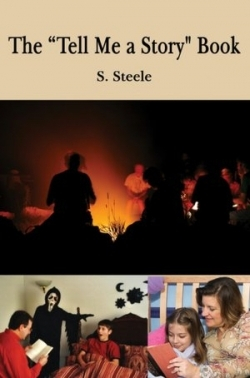The "Tell Me a Story" Book
The “Tell Me a Story“ Book from S. Steele is not a storybook. It is, however, a book aimed at creating storytellers.
This slim volume offers a dozen extremely short tales that are in themselves charming, yet intentionally unfinished—or rather, unpolished. Each has the requisite beginning and ending, but their middles are spare frames, to be fleshed out by others.
In fact, this book is more language arts than fiction—intentionally so on the part of the author. It is a tool for those who want to tell a story, but have no idea how to begin, or any related experience of their own to draw upon.
Many of the tales are derived from the author’s recollections of the summer-night bonfires of his youth at Camp Moosilauke, New Hampshire, in the late 1940s. The tales are familiar yet timeless anecdotes of medieval ghosts and modern killers, mad scientists and crazy cat ladies, innocent travelers and noble heroes, and other vibrant characters.
There is nothing new here, but then, there is not supposed to be. That is the point—for the teller to take an old, familiar story and embellish it, add personal and modern twists to make the story their own. Steele does not want someone to just read his assortment of stories; he wants them to use these tales to create new ones.
While the book is useful, the writing itself is at times awkward or haphazard. In addition, it could do with some copy editing of punctuation, grammar, and spelling. Even so, most errors are minor or even amusing, as in “not one living sole.” While the practiced eye will catch these miscues, they are unlikely to be caught by the ear, for these stories are meant more for telling than reading.
Nine of the twelve stories are under ten pages in length. Only two, “The Man That Wouldn’t Die” and “Terror in the Wilderness,” exceed the dozen-page mark. Such brevity does have its merits, as the stories are short enough for someone to read, remember, and then recite from memory with their own embellishments. They are not meant to be read aloud by someone shining a flashlight on the pages. After all, they are not the final script, only an outline from which the teller is meant to improvise his or her own unique tale.
Steele offers some alternate endings and notes to show storytellers how they might change the yarns as they spin them. He also suggests that the parent, camp counselor, teacher, scout leader, or other narrator “use feeling and suspense” to add life to the tales. While this is basic advice, it is nonetheless sound—the same kind followed by the poet Homer, Scandinavian bards, Celtic singers, and others who have sought to entertain audiences since people first gathered around a fire.
Reviewed by
Mark G. McLaughlin
Disclosure: This article is not an endorsement, but a review. The publisher of this book provided free copies of the book and paid a small fee to have their book reviewed by a professional reviewer. Foreword Reviews and Clarion Reviews make no guarantee that the publisher will receive a positive review. Foreword Magazine, Inc. is disclosing this in accordance with the Federal Trade Commission’s 16 CFR, Part 255.

